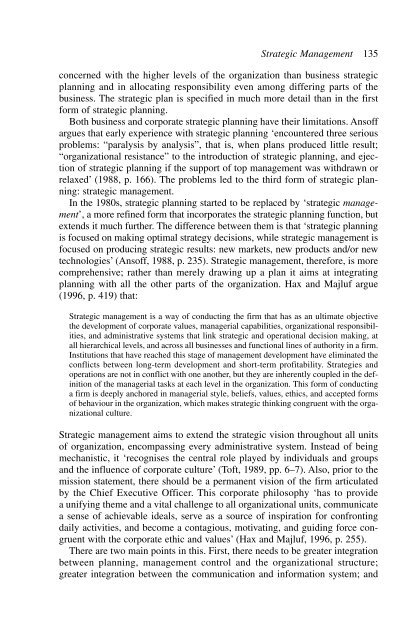Public Management and Administration - Owen E.hughes
Public Management and Administration - Owen E.hughes
Public Management and Administration - Owen E.hughes
Create successful ePaper yourself
Turn your PDF publications into a flip-book with our unique Google optimized e-Paper software.
Strategic <strong>Management</strong> 135<br />
concerned with the higher levels of the organization than business strategic<br />
planning <strong>and</strong> in allocating responsibility even among differing parts of the<br />
business. The strategic plan is specified in much more detail than in the first<br />
form of strategic planning.<br />
Both business <strong>and</strong> corporate strategic planning have their limitations. Ansoff<br />
argues that early experience with strategic planning ‘encountered three serious<br />
problems: “paralysis by analysis”, that is, when plans produced little result;<br />
“organizational resistance” to the introduction of strategic planning, <strong>and</strong> ejection<br />
of strategic planning if the support of top management was withdrawn or<br />
relaxed’ (1988, p. 166). The problems led to the third form of strategic planning:<br />
strategic management.<br />
In the 1980s, strategic planning started to be replaced by ‘strategic management’,<br />
a more refined form that incorporates the strategic planning function, but<br />
extends it much further. The difference between them is that ‘strategic planning<br />
is focused on making optimal strategy decisions, while strategic management is<br />
focused on producing strategic results: new markets, new products <strong>and</strong>/or new<br />
technologies’ (Ansoff, 1988, p. 235). Strategic management, therefore, is more<br />
comprehensive; rather than merely drawing up a plan it aims at integrating<br />
planning with all the other parts of the organization. Hax <strong>and</strong> Majluf argue<br />
(1996, p. 419) that:<br />
Strategic management is a way of conducting the firm that has as an ultimate objective<br />
the development of corporate values, managerial capabilities, organizational responsibilities,<br />
<strong>and</strong> administrative systems that link strategic <strong>and</strong> operational decision making, at<br />
all hierarchical levels, <strong>and</strong> across all businesses <strong>and</strong> functional lines of authority in a firm.<br />
Institutions that have reached this stage of management development have eliminated the<br />
conflicts between long-term development <strong>and</strong> short-term profitability. Strategies <strong>and</strong><br />
operations are not in conflict with one another, but they are inherently coupled in the definition<br />
of the managerial tasks at each level in the organization. This form of conducting<br />
a firm is deeply anchored in managerial style, beliefs, values, ethics, <strong>and</strong> accepted forms<br />
of behaviour in the organization, which makes strategic thinking congruent with the organizational<br />
culture.<br />
Strategic management aims to extend the strategic vision throughout all units<br />
of organization, encompassing every administrative system. Instead of being<br />
mechanistic, it ‘recognises the central role played by individuals <strong>and</strong> groups<br />
<strong>and</strong> the influence of corporate culture’ (Toft, 1989, pp. 6–7). Also, prior to the<br />
mission statement, there should be a permanent vision of the firm articulated<br />
by the Chief Executive Officer. This corporate philosophy ‘has to provide<br />
a unifying theme <strong>and</strong> a vital challenge to all organizational units, communicate<br />
a sense of achievable ideals, serve as a source of inspiration for confronting<br />
daily activities, <strong>and</strong> become a contagious, motivating, <strong>and</strong> guiding force congruent<br />
with the corporate ethic <strong>and</strong> values’ (Hax <strong>and</strong> Majluf, 1996, p. 255).<br />
There are two main points in this. First, there needs to be greater integration<br />
between planning, management control <strong>and</strong> the organizational structure;<br />
greater integration between the communication <strong>and</strong> information system; <strong>and</strong>











